- News
- Reviews
- Bikes
- Accessories
- Accessories - misc
- Computer mounts
- Bags
- Bar ends
- Bike bags & cases
- Bottle cages
- Bottles
- Cameras
- Car racks
- Child seats
- Computers
- Glasses
- GPS units
- Helmets
- Lights - front
- Lights - rear
- Lights - sets
- Locks
- Mirrors
- Mudguards
- Racks
- Pumps & CO2 inflators
- Puncture kits
- Reflectives
- Smart watches
- Stands and racks
- Trailers
- Clothing
- Components
- Bar tape & grips
- Bottom brackets
- Brake & gear cables
- Brake & STI levers
- Brake pads & spares
- Brakes
- Cassettes & freewheels
- Chains
- Chainsets & chainrings
- Derailleurs - front
- Derailleurs - rear
- Forks
- Gear levers & shifters
- Groupsets
- Handlebars & extensions
- Headsets
- Hubs
- Inner tubes
- Pedals
- Quick releases & skewers
- Saddles
- Seatposts
- Stems
- Wheels
- Tyres
- Health, fitness and nutrition
- Tools and workshop
- Miscellaneous
- Cross country mountain bikes
- Tubeless valves
- Buyers Guides
- Features
- Forum
- Recommends
- Podcast
review
£2,150.00
VERDICT:
A British designed bike that is perfect for year-round British road cycling
Weight:
8,800g
Contact:
At road.cc every product is thoroughly tested for as long as it takes to get a proper insight into how well it works. Our reviewers are experienced cyclists that we trust to be objective. While we strive to ensure that opinions expressed are backed up by facts, reviews are by their nature an informed opinion, not a definitive verdict. We don't intentionally try to break anything (except locks) but we do try to look for weak points in any design. The overall score is not just an average of the other scores: it reflects both a product's function and value – with value determined by how a product compares with items of similar spec, quality, and price.
What the road.cc scores meanGood scores are more common than bad, because fortunately good products are more common than bad.
- Exceptional
- Excellent
- Very Good
- Good
- Quite good
- Average
- Not so good
- Poor
- Bad
- Appalling
Fast and sporty, with all the practicality and dependability of hydraulic disc brakes, wide tyres and space for full-length mudguards, the brand new Whyte Wessex is a bike that is up to the task of taking on the roughest roads and toughest weather.
Racing aside, it's all the bike you really need for year-round riding in the UK, fast enough for sportives and pacy training runs, comfortable and reliable for grinding out winter miles, and at home on longer commutes. Only a British company could design a bike that is absolutely, perfectly, 100 per cent suited to the demands of year-round UK road cycling.
> Find your nearest dealer here
The Wessex has been a long time coming from Whyte. Although the traditionally mountain bike-focused company has gradually moved into the road bike market with the likes of the Suffolk we reviewed last year, the brand new Wessex 'is conceived to be the ideal British road bike' and has only been made possible with the advent of the latest technology – advances such as wide tubeless-ready rims, decent tubeless tyres, hydraulic disc brakes and thru-axles.
With those technologies now readily available, Whyte set itself the goal of creating the most dependable, reliable, comfortable bike for surviving the worst conditions, and it would appear it has ticked all those boxes. This is a very impressive bike.
Ride and handling
My first ride on the Wessex was an enjoyable, if tiring, 140km loop of some of the finest Cotswolds countryside, the testing ground that helped form Whyte designer Ian Alexander's blueprint for the new bike. With a change to a 120mm stem and the saddle set to my height, I immediately felt at home on it, and that's always a good sign of a test bike – that no radical changes are required and the fit and position feel natural.
Rolling along country lanes, it's immediately obvious that the bike benefits from a stable and surefooted balance, a result of the long wheelbase – 1003.3mm on this size 54cm model. The steering feels predictable and relaxed in a straight line and weaving through the turns. Out of the saddle and up steep and long ascents, the Wessex climbs authoritatively, the front end displaying a crispness with no hint of flex from the fork or rub from the disc brake.
As you settle into a steady rhythm, the 30mm-wide Schwalbe S-One tyres roll with surprising pace for such a big tyre. There's no hesitation in the way they pick up and maintain speed, and no concern that they generate any excessive drag compared with narrower tyres. The large volume tyres, run at a low pressure – between 70-80psi (it's worth experimenting with these wider tyres to find the sweet spot) – really take out the hard edges of some of the more badly surfaced roads sadly in abundance in the Cotswolds.
When the pace picks up the Wessex displays the direct handling of a race bike, nimble when asked to perform sudden changes in direction. The get-up-and-go response of the bike is incredible. That it can on the one hand travel along at a serene pace with ease and then react so positively to more aggressive riding, and be as fast as you like, is a big appeal of the Wessex. It's no slouch, that's for sure, yet it's as comfortable as you like if a relaxed cruising speed is your highest ambition for a cycle ride.
It corners enthusiastically too, with the wheels tracking any line you want to pick, no matter how rough or chattery the road surface might be through the apex. The hydraulic disc brakes play their part here, providing unparalleled control and precise speed adjustment when needed, all with one-finger braking. Both frame and fork display a high level of lateral stiffness, ensuring the Wessex has a very direct and responsive character when piloting through the bends.
The geometry of the Wessex allows for a comfortable riding position. Whyte has used a long fork to provide the necessary wide tyre and mudguard clearance, but has kept the head tube short. This has the effect of preventing the front end from looking tall, and also preventing too lofty a handlebar position. To provide some context with numbers, the reach and stack figures (the horizontal and vertical measurements from the centre of the bottom bracket to the top of the head tube) for the size 54cm bike I rode are almost identical to the medium size Canyon Endurace CF SLX I recently tested. The 382mm reach is the same while the Whyte has a 5mm longer stack, 583mm to 578mm.
Other numbers for you: the top tube is 555mm, the head angle is 73 degrees, the head tube is 160mm, and the chainstays are 425mm.
It's a geometry that works really well if you value comfort for banging out the long rides at the weekend, but if you slam the stem (remove all the spacers) and make use of the compact drops, you can get a low position that should satisfy any aero enthusiasts.
Frame design
Whyte has designed a very modern looking bike, using a full carbon fibre frame and fork with aero shaped tube profiles and a wide stance fork, providing huge clearance around the 30mm tyres – space to accommodate the custom full-length mudguards. Whyte has cleverly designed the mudguards to fit seamlessly with the Wessex's appearance; it's probably the smartest mudguard-equipped road bike to ever pass through the road.cc office. The mudguards are an optional extra, with a price yet to be confirmed...
The curvaceous fork has the same axle-to-crown length as a cyclo-cross fork, which provides the necessary tyre and mudguard clearance, but Whyte has sliced the bottom of the head tube away to push the fork crown higher up to prevent the front from getting too high.
The aero-shaped down tube gives way to a regular seatpost with a 27.2mm round diameter, chosen because it allows a rear light to be fitted easily and also provides a bit more comfort. The seat clamp is integrated into the top tube with a rubber flap shielding it from the elements.
Also contributing to the comfort are the skinny seatstays, while chunky chainstays provide the stiffness necessary when stomping on the pedals.
There are 12mm thru-axles front and rear, with Shimano's flat mount standard fixing the hydraulic brake callipers in place. All cables and hoses are routed inside the frame and fork and there is a tapered head tube and externally threaded bottom bracket, used over a press-fit BB because it is simple, proven and works.
Equipment
There is just one model of Wessex available (though Whyte did show a very pimp SRAM eTap bike at the Cycle Show) and it comes with a Shimano Ultegra 6800 11-speed drivetrain with an FSA Gossamer Pro EVO-386 50/34 compact chainset and an FSA Evo bottom bracket.
The brakes are Shimano ST-685 levers, containing mechanical shifting internals with hydraulic brake levers, operating BR-805 flat mount callipers. It's all solid and dependable equipment, smooth shifting and powerful brakes.
The 11-32t cassette helps on the hills, especially the steeper gradients where you can begin to notice the weight of a bike. At 8.8kg (without mudguards) the Wessex is comparable to similarly equipped bikes, but you can get lighter: the Orro Gold STC Disc is similar money but comes in at 8.5kg, so the Whyte is carrying a bit of excess. The weight is rarely an issue on the road, I hasten to add.
Displaying its mountain bike background, where tubeless tyres are pretty much the standard, Whyte has specced Easton AR-21 tubeless-ready rims with equally tubeless-ready Schwalbe S-One 30mm tyres. Tyres are getting wider, that much we know, but the key to unleashing the full benefits of wider tyres is the use of wider rims; these new Easton rims are wide, 21mm internally and 25mm externally, to be precise. That gives the tyre a broad platform for good stability at lower pressures and means they measure up a bit wider.
The rims are laced to Whyte's own aluminium hubs with double sealed bearings, with 28 DT Competition butted spokes in each wheel.
As for the S-One tyres, there's not much I can say that Mike didn't already gush about in his review last year. Considering the size and the tread pattern, they're a fast-rolling tyre and provide stacks of traction in tricky conditions, when the road surface is coated with rain, mud and gravel. The V-Guard technology ensures the tyres withstand flats impressively well, even at lower pressures and slamming into rocks and holes. They also, via the larger contact patch and the dimpled tread pattern, let you make the most of the powerful hydraulic disc brakes.
Whyte has finished the bike off with its own label parts for the handlebar, stem, seatpost and saddle. The compact wing-shaped handlebar has a comfortable shape and generous length drops, and the stem length is size-specific, 110mm on the 54cm bike, but I upsized to a 120mm stem. The saddle has a fairly generic shape but it's comfortable for longer rides and is well padded, providing extra comfort over rougher surfaces.
Conclusion
What a bike! For grinding out long winter rides with mudguards or tackling summer sportives without, the Wessex is the ideal choice. Okay, so it's not the lightest option, but it's more than comfortable and smooth enough and is fast and fun when you want to up the pace, but calm and collected when pedalling at a steady clip. And at £2,150 it's (relatively speaking) good value too – cheaper than the similarly specced Cannondale Synapse Disc.
It's very much a bike of the moment. It meets the needs of British cyclists wanting a dependable and reliable bike for riding in all weathers, and the equipment is smartly chosen to ensure it delivers brilliant performance and reliability. For many people, this is going to be the perfect British road bike.
Verdict
A British designed bike that is perfect for year-round British road cycling
road.cc test report
Make and model: Whyte Wessex
Size tested: 54cm
About the bike
State the frame and fork material and method of construction. List the components used to build up the bike.
Uni-directional Multi Monocoque with Flat Mount 160 Disc mount, DOX internal cable routing, Verti-Grip integrated seat clamp system, concealed eyelets for Mud Guards and 142mm rear dropouts with 12mm through axle
Fork: Straight Bladed Carbon Front Fork, Tapered Alloy Steerer with, 12mm x 100mm through axle, concealed eyelets for Mud Guards
Rear Shock: N/A
Headset: FSA No. 42 Integrated Road, 1 1/2" lower and 1 1/8" upper Sealed Cartridge Bearings
Rear Hub: Alloy, Double Sealed Cartridge Bearing Hub, Centre-lock, 12mm x 142mm Through Axle, 28 Hole
Front Hub: Alloy, Double Sealed Cartridge Bearing Hub, Centre-lock, 12mm x 100mm Through Axle, 28 Hole
Spokes: DT Competition butted, Black Sandvik Stainless with Black Brass Nipples
Rims: Easton AR-21, 21mm wide Tubeless Ready Rims, 28 Hole
Tyres: Schwalbe S-ONE, 700 x 30c, TL-Easy Tubeless System, MicroSkin Puncture Protection, Folding
Shift Levers: Shimano ST-685 Ultegra, 11 Speed
Front Mech: Shimano FD-5800 105, 11 Speed
Rear Mech: Shimano RD-6800 GS Ultegra, 11 Speed
Cassette: Shimano CS-5800 105 11-32, 11 Speed
Chain: Shimano, HG-601, 11 Speed
Crankset: FSA Gossamer Pro EVO-386 DB 34-50, 11 Speed, Compact Double
Bottom Bracket: FSA EVO-8681, 68mm
Seatpost: Whyte 20mm Offset, 27.2mm x 350mm, 1pcs 3d Forged 6061 Alloy, 2 Bolt Clamp
Saddle: Whyte Custom Road, with lightweight foam, Triple Panel Design
Handlebar: Whyte Road, 31.8mm, Compact "Wing" Bar
Stem: Whyte -6 Deg/6 Deg, 100mm 52cm, 110mm 54cm, 120mm 56/58cm
Grips: Whyte Anti Slip with 3M Reflective logos on tapes
Front Brakes: Shimano BR-805 Hydraulic, Centre-lock 160mm Rotor, Internal Routing
Rear Brakes: Shimano BR-805 Hydraulic, Centre-lock 160mm Rotor, Internal Routing
Brake Levers: Shimano ST-685 Ultegra
Pedals: Fibre Reinforced Composite Platform
Tell us what the bike is for, and who it's aimed at. What do the manufacturers say about it? How does that compare to your own feelings about the bike?
Whyte says:
"The all new Wessex is conceived to be the ideal British road bike. Developed and specified for riding on all road surfaces, the Wessex uses the very latest in tubeless ready, high air volume Schwalbe tyres on 21mm wide Easton AR rims.
Whether you're commuting longer distances, winter training or entering summer sportifs, the Whyte Road Disc range offers Cyclo Cross durability with pure Road geometry.
12mm through axles, tubeless tyres, disc brakes and the ability to fit full length mud guards makes the Wessex arguably the most versatile and capable carbon road bike we have ever made."
Frame and fork
Overall rating for frame and fork
8/10
Tell us about the materials used in the frame and fork?
Full carbon fibre frame and fork with internal cable routing, tapered head tube and external bottom bracket.
Tell us about the geometry of the frame and fork?
Endurance road bike geometry.
How was the bike in terms of height and reach? How did it compare to other bikes of the same stated size?
Very good, with a change to a 120mm stem I achieved a good fit on the bike.
Riding the bike
Was the bike comfortable to ride? Tell us how you felt about the ride quality.
Very comfortable, the bike handles rough roads really well.
Did the bike feel stiff in the right places? Did any part of the bike feel too stiff or too flexible?
It's stiff when you put down the power.
How did the bike transfer power? Did it feel efficient?
Very, yes.
Was there any toe-clip overlap with the front wheel? If so, was it a problem?
None.
How would you describe the steering? Was it lively, neutral or unresponsive? Predictable.
Tell us some more about the handling. How did the bike feel overall? Did it do particular things well or badly?
Very stable and predictable handling at low and high speed.
Which components had the most effect (good or bad) on the bike's comfort? would you recommend any changes?
The 30mm tyres make a big contribution to the performance of the Wessex.
Which components had the most effect (good or bad) on the bike's stiffness? would you recommend any changes?
No changes.
Which components had the most effect (good or bad) on the bike's efficiency? would you recommend any changes?
No changes.
Rate the bike for efficiency of power transfer:
8/10
Rate the bike for acceleration:
8/10
Rate the bike for sprinting:
8/10
Rate the bike for high speed stability:
9/10
Rate the bike for cruising speed stability:
8/10
Rate the bike for low speed stability:
8/10
Rate the bike for flat cornering:
8/10
Rate the bike for cornering on descents:
9/10
Rate the bike for climbing:
7/10
The drivetrain
Rate the drivetrain for performance:
8/10
Rate the drivetrain for durability:
8/10
Rate the drivetrain for weight:
7/10
Rate the drivetrain for value:
8/10
Tell us some more about the drivetrain. Anything you particularly did or didn't like? Any components which didn't work well together?
The Shimano/FSA package worked very well together.
Wheels and tyres
Rate the wheels for performance:
8/10
Rate the wheels for durability:
8/10
Rate the wheels for weight:
8/10
Rate the wheels for comfort:
8/10
Rate the wheels for value:
8/10
Tell us some more about the wheels.Did they work well in the conditions you encountered? Would you change the wheels? If so, what for?
The wide profile rims balloon the tyres up bigger than the stated size, and provide a very secure platform for the tyres.
Rate the tyres for performance:
9/10
Rate the tyres for durability:
8/10
Rate the tyres for weight:
7/10
Rate the tyres for comfort:
9/10
Rate the tyres for value:
8/10
Tell us some more about the tyres. Did they work well in the conditions you encountered? Would you change the tyres? If so, what for?
They tackle all sorts of conditions really well, and are faster than you might expect them to be.
Controls
Rate the controls for performance:
8/10
Rate the controls for durability:
8/10
Rate the controls for weight:
8/10
Rate the controls for comfort:
8/10
Rate the controls for value:
8/10
Tell us some more about the controls. Any particularly good or bad components? How would the controls work for larger or smaller riders?
Comfortably shaped handlebar and saddle.
Your summary
Did you enjoy riding the bike? Yes
Would you consider buying the bike? Yes
Would you recommend the bike to a friend? Yes
Rate the bike overall for performance:
9/10
Rate the bike overall for value:
9/10
Use this box to explain your score
The lines of endurance road bike design are all gradually heading in the same place, and the Whyte Wessex is a fine demonstration of a bike that meets the requirements of most British cyclists.
About the tester
Age: 31
I usually ride: My best bike is:
I've been riding for: 10-20 years I ride: Every day I would class myself as: Expert
I regularly do the following types of riding: road racing, time trialling, cyclo-cross, commuting, touring, mountain biking
David worked on the road.cc tech team from 2012-2020. Previously he was editor of Bikemagic.com and before that staff writer at RCUK. He's a seasoned cyclist of all disciplines, from road to mountain biking, touring to cyclo-cross, he only wishes he had time to ride them all. He's mildly competitive, though he'll never admit it, and is a frequent road racer but is too lazy to do really well. He currently resides in the Cotswolds, and you can now find him over on his own YouTube channel David Arthur - Just Ride Bikes.
Latest Comments
- Secret_squirrel 6 min 36 sec ago
Having them say they do isn't the same as them actually doing anything significant. Rather like BC in fact.
- NickSprink 14 min 1 sec ago
Not sure who is "grinding to a halt" in London. My journey this morning during rush hour from Paddington Station to my office by Trafalgar Square...
- brooksby 22 min 25 sec ago
Thanks - was about to say that.
- Langoo 1 hour 18 min ago
".. there were no criminal acts which would allow prosecution”...
- Miller 1 hour 35 min ago
Don't buy American.
- brooksby 1 hour 41 min ago
So many motorists don't observe zebra crossings....
- lerrup 2 hours 25 min ago
I don't quite get internal frame storage, surely you're making the frame weaker by cutting a hole in it? Are they really saying they've got more...
- RobD 3 hours 17 min ago
Well they're definitely not cheap
- chrisonabike 4 hours 17 min ago
And other counties also have done this IIRC with total cost/ benefit - including contribution to businesses and shopping - with similar results. (I...
- froze 7 hours 57 min ago
I pray Wiggins has found peace and happiness; he was a great cyclist, no one can take that away from him. And a huge thanks to Lance Armstrong for...












































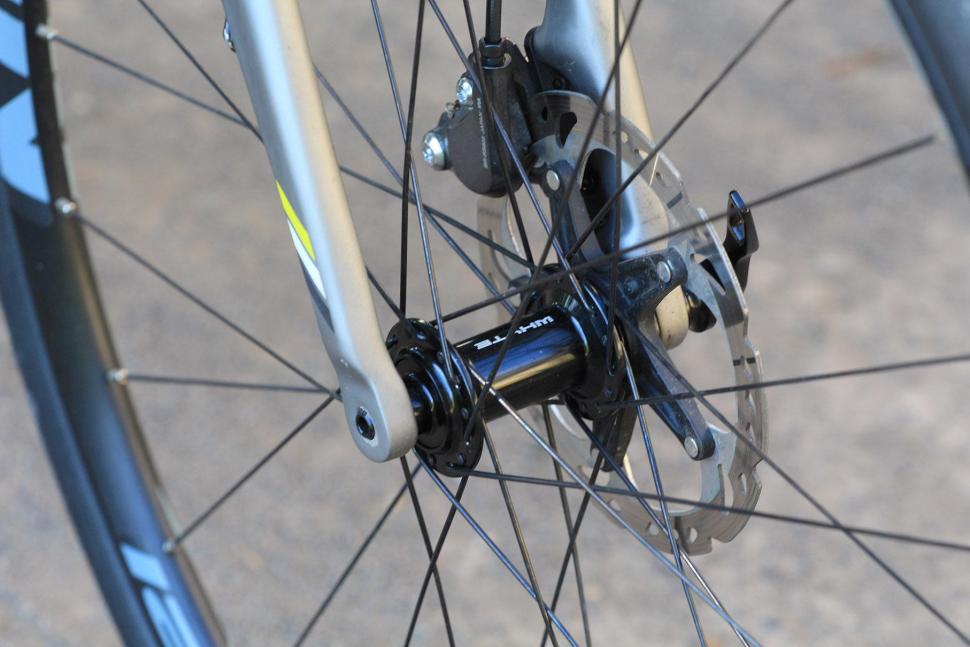
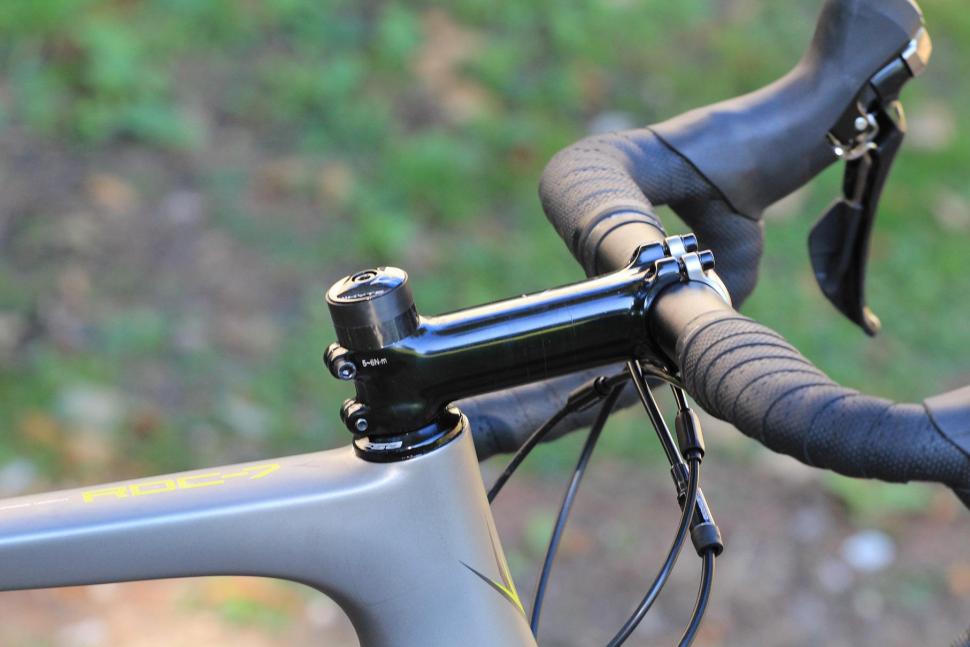

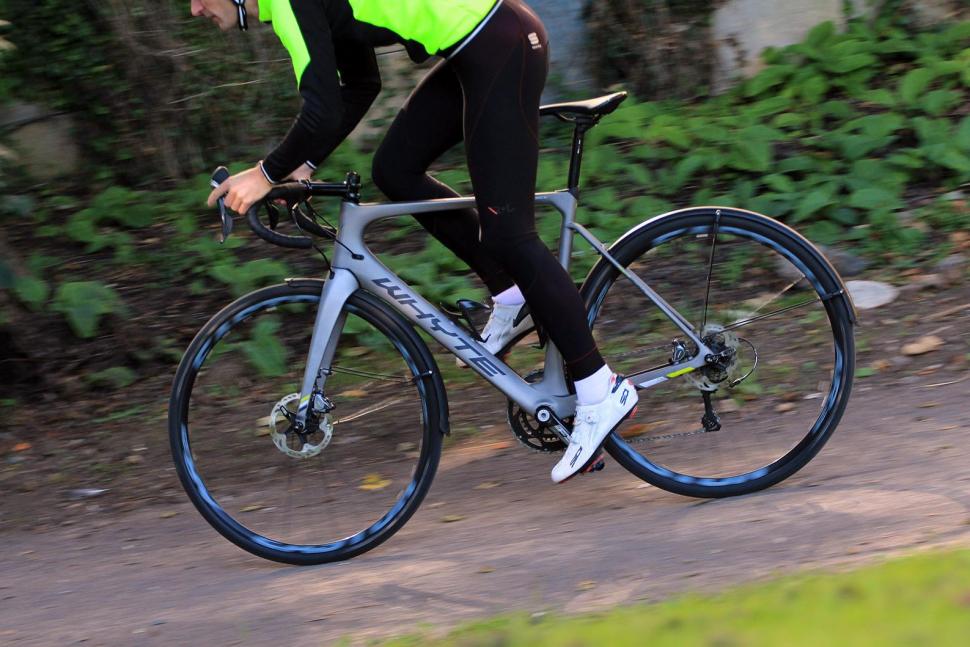
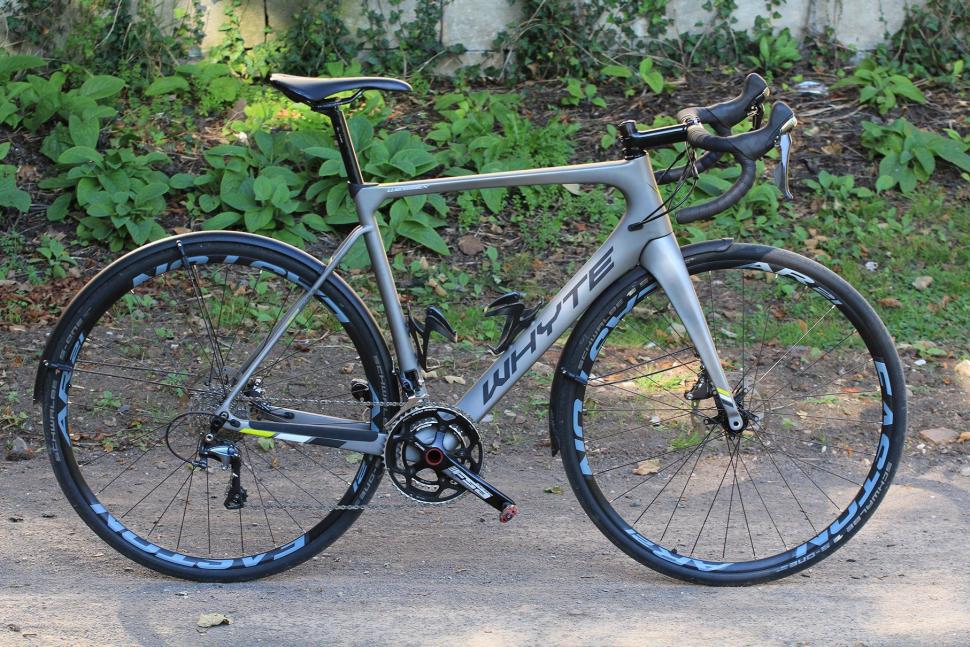
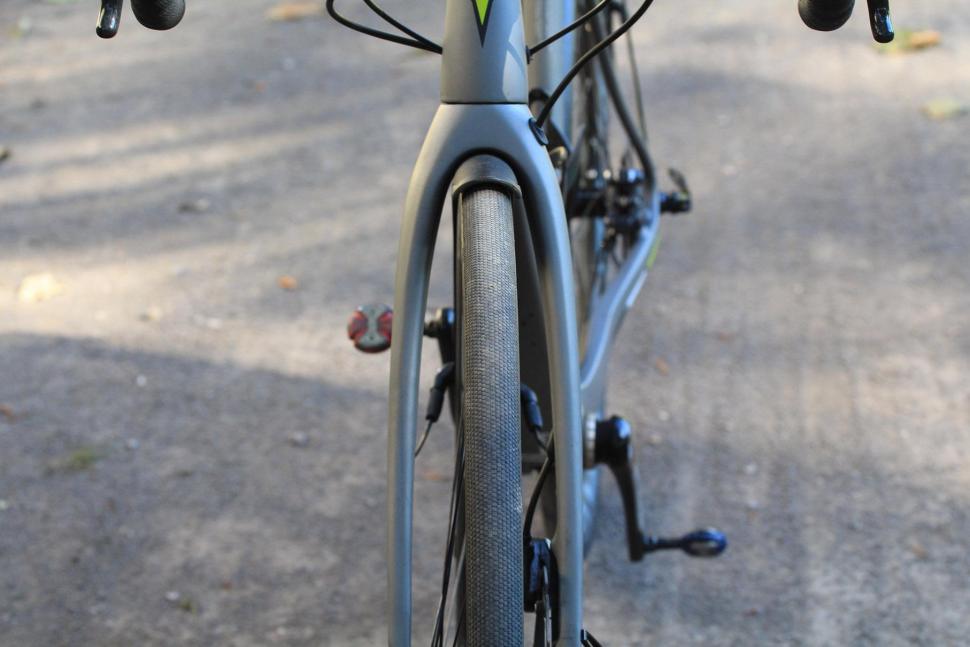




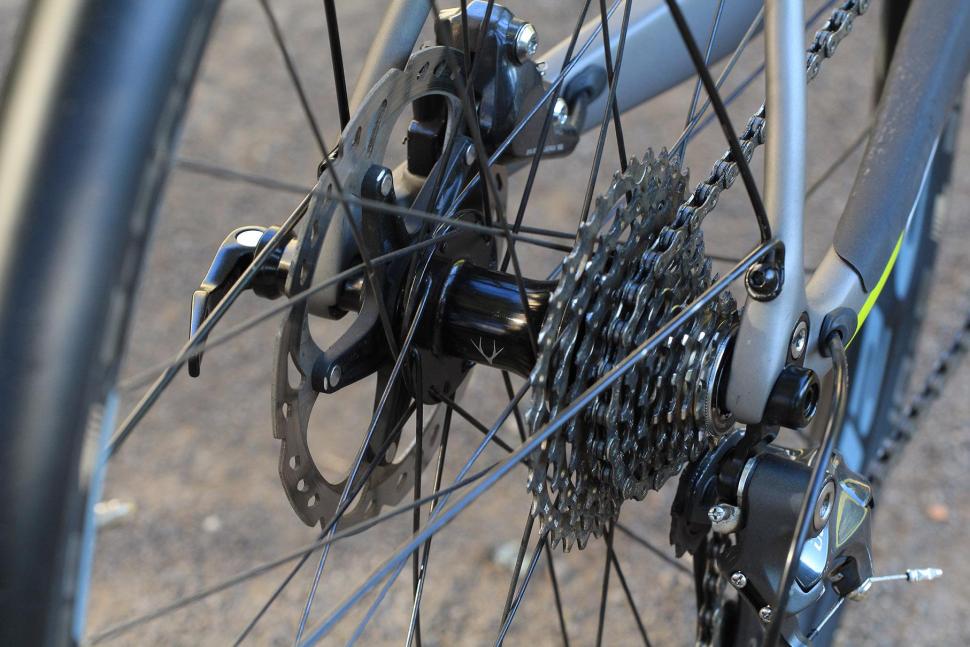
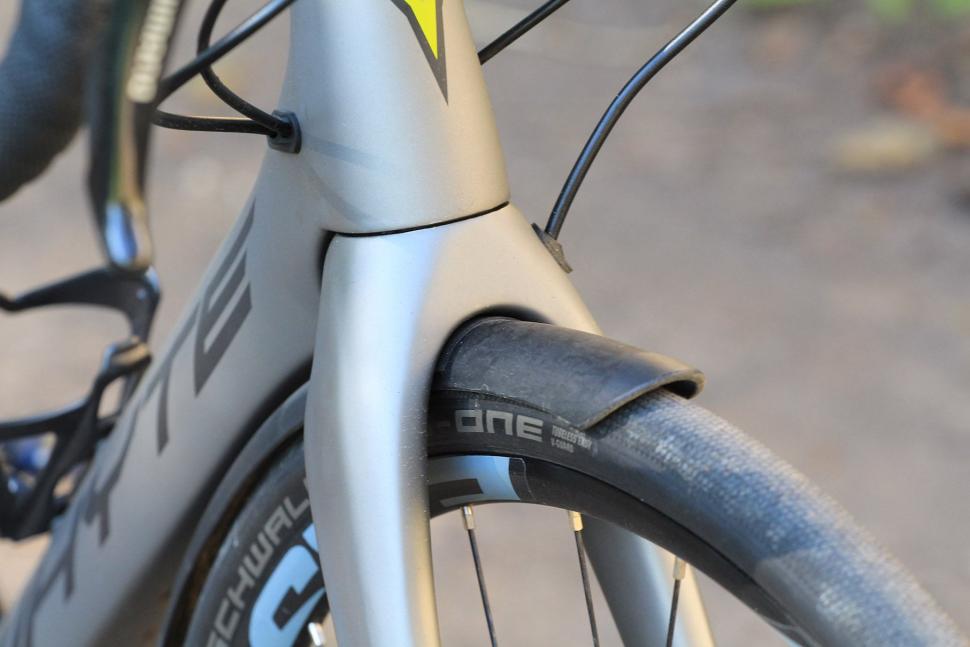
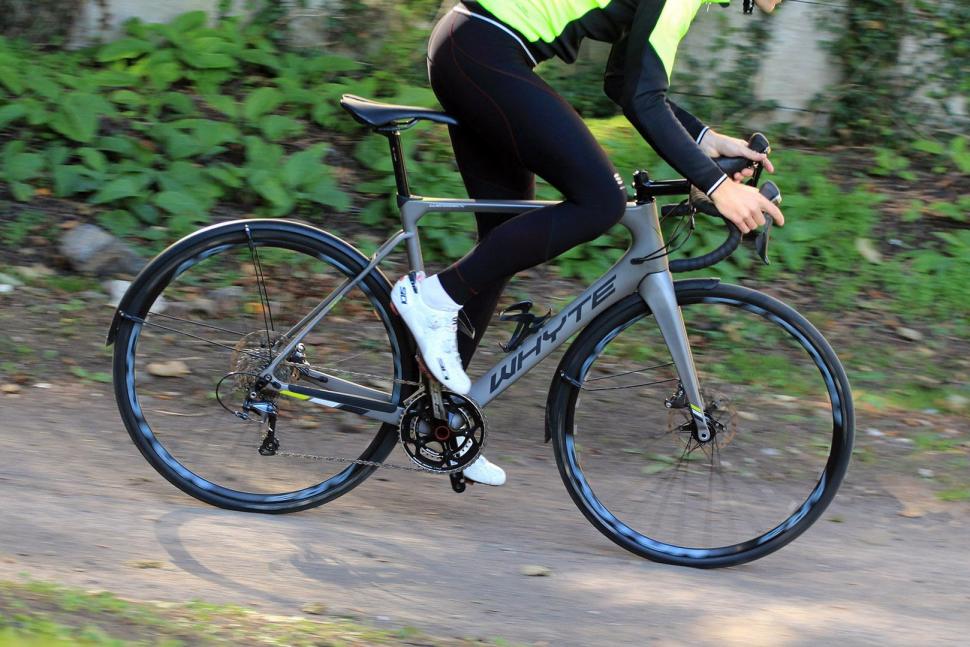




Add new comment
28 comments
@DaveArthur I hope you're right with your review.
I've bought myself a 2018 Whyte Wessex (still a couple weeks for it to get delivered to the LBS). I will be swapping the R8000 sti's, brakes and rear mech for RS685 and 105 (long story short, selling the R8000's bits and have the RS685 left over from a previous build. I'm also swapping the Whyte wheels for DT Swiss R32's.
You were bang on with your review of the Canyon Ultimate CF SLX Disc 8.0 Di2 - I bought the non Di2 version and I love it, let's hope this bodes well for my new commuter!
Not convinced by Whyte's own brand hubs - I've got a Whyte hybrid that hasn't had that much use for it's age and the rear hub bearing races are already knackered.
Bought a new hub from local bike shop (Whyte dealer) for £26, but when I went to swap them over, the flanges are completely different, so I have the choice of having to buy a load of new spokes, or trying to swap out the races.
Agree with the comments about their customer service - impossible to get an answer from them.
Interesting you said that. I have a mate at work who rides a Whyte hybrid and is looking for his first n+1. I sent him the link to this article and he said we wouldn't condsider another Whyte.
"... 30mm-wide Schwalbe S-One tyres roll with surprising pace for such a big tyre. .."
Big, small, wide, narrow, hard, soft are all relative terms depending on the scale of reference and individual experience. Objectively 30mm isn't big. It's barely adequate in many riding scenarios especially commuting on rubbish roads.
There is nothing surprising in wider tyres rolling fast unless someone is living under the rock. Fast riding doesn't end on 25mm. Even 2" wide top end XC mtb tyres roll as fast as some winter/training 700c tyres e.g. Gatorskin garden hoses...
Agreed. The best tyres I own are the S-One, G-One (35c), Kojak (35c) and Vittoria Hyper Voyager (38c). All superb.
Like it apart from:
1). Clearance on those mudguards looks minimal
2). Weight
I've had the 4 Seasons Hunt wheelset on my full carbon summer bike for about a year and absolutely love them, they're stiff, smooth and light and seem pretty tough as well. I've actually just bought a set of their Winter rim brake wheels for my steel winter bike and they're equally awesome, not mega light but well built and very, very smooth - belting value for £229.
Ahh the crazy world of bottom bracket 'standards'! My assumption would be that it is just a normal 68mm threaded insert inside the carbon frame and they have provided a BB386 bottom bracket and matching crankset as a halfway-house to a full PF30/BB30 setup with the larger diameter crank axle - but you never know! I can't really imagine that they would spec the frame insert for a pressfit BB, then fit a separate 68mm insert/sleeve, then fit a hybrid BB and crankset! What would be the point? (apart from covering all bases I guess?!)
I would be interested to hear this confirmed for definite though. I'm interested in this bike and would want to complete the Ultegra setup with an Ultegra crankset and BB. I'd prefer to stick to 68mm threaded as I have had less problems with them but if I'm installing it myself (i.e. properly) I have no qualms with a press fit BB. I would just want to know either way before I buy!
I have also been trying to find out more about mudguard attachment points. It looks like the eyelets/inserts are at 90 degrees to the normal locations on the forks and the seat-stays. Does this mean we can only fit the bespoke Whyte mudguards (which might be fine, I don't know*) and not something like SKS Chromoplastics, without some ugly little 90 degree brackets or by bending the SKS stays through 90 degrees at the attachment point? *Still on the subject of the mudguards, I'd be interested to hear any comments from the reviewer on the performance of these mudguards, i.e. coverage, did they rattle, what materials are they made from, do they seem robust etc etc. I am always wary of manufacturers own bespoke mudguards and frames that cannot accept a 'normal' setup!
No dealer I have phoned is intending stocking this bike, so none of them could answer my question. I filled in the Whyte "contact us" web-form and got a prompt reply asking for my phone number to call me back but over two weeks later no-one has called! I'm about to go for the other bike on my shortlist .................
68mm threaded sleeve, so you can put your Hollotech II crankset in with a hollowtech II bottom bracket. But you'll have to throw the FSA crank away as it'll only work with a single bottom bracket, and nobody else uses it so you'd get pennies on Ebay.
The eyelets are in odd places to avoid conflicts with the disc brake calipers. I have the Whyte mudguards - do not buy. They are absolute rubbish, I can't wait for one to break to give me an excuse to chuck them in the bin. The instant you take a hand off the handlebar, the front guard rattles like crazy.
Same experience here. I have the Cornwall, it's ok, but I'll never buy Whyte again because they simply don't care about their customers.
Can someone clarify? - are we saying the bottom bracket shell is threadless but contains an adaptor which is bonded in like this?? :
http://www.chainreactioncycles.com/fsa-bb30-threaded-adapter-b3119-/rp-p...
And then the Megaevo bottom bracket cups linked to above screw into that adaptor?
@BendertheRobot - The width of the rim that you put them on obviously makes a difference, but I have Schwalbe Pro Ones in 23mm and 25mm on different rims. The 23's measure up around 26mm actual and the 25's are nearer to 28mm. So I reckon Schwalbe probably size up large generally.
I know! Just checking there wasn't something I was unaware of.
https://roubaixcycling.cc/2016/09/01/the-road-nicer-travelled-schwalbe-s...
My new n+1, sorry cipollini head over rules heart until next spring.
32mm wide S-One? Measured at or stated to be?
30mm. Small typo that made it through to the final copy by mistake because the spec sheet is wrong. They measure closer to 31mm on these wide Easton rims though
Like the look of the bike, in particular that shiny grey for a proper british winter bike. Were those 30mm or 32mm tyres that you're topping right up to the recommended maximum, in order to support all 10 stone of you?
I was going to say! 80PSI is loads in a 30mm tyre. I ride my S-Ones at far less than that and I'm much (MUCH) heavier. Try 60 PSI.
Not bad, but I question the choice of EVO-386 chainset. Come time to replace the bottom bracket (which on a winter bike will be at least once every 10,000 miles or so) and you'll have a hard time finding anyone who sells anything compatible.
These days I stick with standard threaded 68mm shells. I don't care about the weight or imagined flexing. Proper threaded shells don't creak and are cheap and easy to find parts for. Whyte should bear this in mind.
The frame does have a 68mm threaded bottom bracket, and uses this threaded FSA bottom bracket (http://www.fullspeedahead.com/products/bottom-brackets/megaevo-bottom-br...)
Yes it does, but it uses an EVO-386 chainset (I said this) which requires the use of a bottom bracket that is difficult to find. And there's only one bottom bracket I know of available to buy, so you have extremely limited choice too. And that shell? It's glued into a carbon frame.
They should have stuck with something more common.
Not really sure of your problem? They are not that dificult to find. You say yourself you have found one to buy?
One online shop sells them. One.
I can go into any bike shop, anywhere in the country, and pick up a Hollowtech II bottom bracket. It's easy, everyone has them. Nobody has the BB386 EVO bottom bracket, it's as rare as hen's teeth.
Currently in my top 3 for new bike. Currently with the weak £ it's terrific value for us outsiders. Only thing is the alloy steerer, no doubt to keep the price down.
@Dicklexic
Which Hunt wheels did you go for? What's your impression so far? Also tell me type of riding you do and general mileage, as I would like to gather some impressions about them (longevity, durability of hubs, spokes:)).
O
I've got the Hunt Mason 4 Season Disc which I've had since April last year when I bought them for my previous bike (an alloy Synapse). They have been brilliant to be honest. Covered somewhere in the region of 5500km so far. At 90kg I am at the upper end of the rider weight range, and have used them in a full range of conditions, mostly on my road bike (including two editions of the White Roads Classic on gravel roads) but they have also seen use on my 29er hardtail for a beach race and also my CX bike for a few races. Quality is very good and durability has proven excellent so far, especially considering the work they've had to do. Sadly I did manage to trash one of the rims after a mis-timed hop up a kerb on my commute home one night. The rear rim was very badly damaged, but remarkably (due no doubt to being tubeless) the tyre stayed inflated, and being disc brakes they allowed me to continue my ride home despite the rear wheel being very badly buckled! I don't think many wheels would've coped as well. A new rim was purchased from Hunt who responded really quickly and the rear wheel was put back into action. They feel great on the bike, being a decent weight and have a lovely compliant yet taught feel to them. The real icing on the cake is the ability to run tubeless (although obviously there are more and more tubeless ready alternatives coming to market all the time) and they are adaptable to all the various axle 'standards'!. I would have no hesitation in recommending them and in fact a couple of friends have already bought their own and have also been very happy.
Agree with the positive things that have been said about Hunt wheels in this thread.
One small caveat though (and it might not be an issue to many), but it would be great if they offered the rims in different spoke drillings. It's fine if you are buying a complete wheel from them, or replacing a broken rim like-for-like, BUT, if you wanted to build up a wheel using a Hunt rim and your own hub, you might come up stumped if the numbers don't match. The issue I'm having is trying to get a replacement rim for my 32 hole drilling Schmidt dynamo hub and I don't think Hunt is going to be the answer. That said, they are supposedly imminently releasing their own dynamo wheel
A very decent looking package at a great price. Last year I bought the Cannondale mentioned at the end of the article and have been (and still am) very pleased with it, although mudguard mounts are one feature missing from my Synapse. Not in the market for a new bike at the moment but this would be right up there on the shortlist. I can also vouch for the tubeless S-One tyres being excellent. I have upgraded to Hunt wheels and have used S-Ones and Pro-Ones over the past 18 months with great success. This Whyte does indeed look like the perfect bike for many British riders.
Having recently converted to a Datum I can vouch for the versatility of this style of bike. The trick is having all that utility and not making them boring to ride. The Datum gets this and it looks like this does too. This is something that the UK brands are really nailing at the moment and it's great to see. Genesis, Whyte, Kinesis, Mason all getting this spot on at the moment and a great reason to buy a local marque for this style of bike.